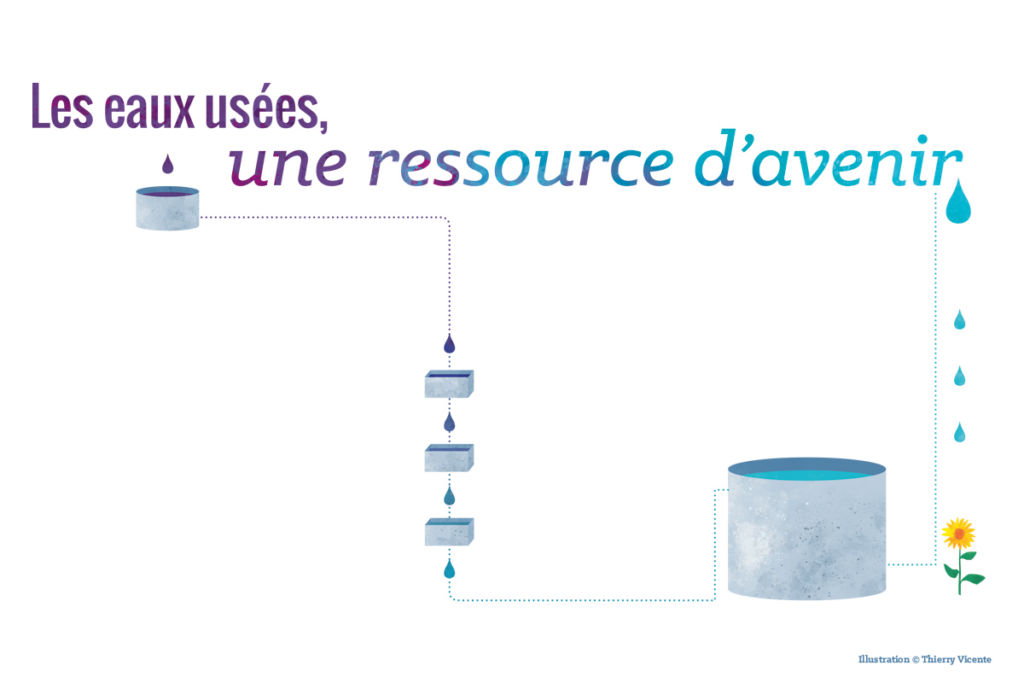[LUM#9] Wastewater, a resource for the future
To tackle water shortages and preserve this dwindling resource, researchers at theEuropean Membrane Institute are proposing an innovative wastewater treatment process. The aim is to produce high-quality water from wastewater treatment plants, which can then be reused.

Pesticides, insecticides, pharmaceutical residues, endocrine disruptors - all these substances produced by human activity find their way into the environment, and water is no exception. This phenomenon is all the more problematic in that these micropollutants are harmful even in very small doses.
To preserve this blue gold at a time when water scarcity is becoming a major concern, researchers are developing new processes designed to effectively eliminate these substances from wastewater treatment plants. The challenge is twofold: to limit the impact of micropollutants on the environment, and to enable the reuse of treated wastewater. A promising way forward for optimizing the management of aquatic resources.
Refractory pollution
"Today, around 80% of micropollutants are eliminated by biological treatment in wastewater treatment plants, thanks to activated sludge, which naturally degrades them," explains Julie Mendret, a researcher at theEuropean Membrane Institute (IEM). The problem is that some molecules are not biodegradable and remain in the water even after this treatment. "There remains 20% of refractory pollution that is discharged into the natural environment. In France, unlike other countries such as Switzerland, there are no standards for micropollutants leaving treatment plants", stresses the researcher.
The consequences for the environment are well known: these micropollutants, which return to the water circuit, are deposited in silt and affect the entire ecosystem. "Studies show that fish living close to plant discharges are contaminated by these molecules. These toxic compounds have become a major issue, and the wastewater treatment plants of the future will have to modernize in order to limit their emissions", explains Julie Mendret. The researcher decided to meet this challenge by proposing an innovative and intensive wastewater treatment process.
Innovative and intensive
Today, there are two types of process for treating these micropollutants: membrane processes and advanced oxidation processes.
The first is based on the use of membranes, which retain very small molecules and allow the water to pass through. This filtration method is effective, but has its limitations: "Although the pollutants are isolated from the water, they are not destroyed, and must then be removed," explains Julie Mendret.
Another solution: advanced chemical oxidation processes. Ozonation is particularly effective on micropollutants," stresses the researcher. They are oxidized by ozone, which breaks them down into smaller and smaller molecules, until, in the case of complete mineralization, CO2 and H2O molecules are obtained". The pollutant is finally eliminated, leaving only harmless molecules of water and carbon dioxide. An effective but imperfect method: on the one hand, ozonation is not very cost-effective for pollutants that are very dilute in water, and on the other, it can give rise to the formation of toxic by-products.
A 2-in-1 process
Faced with these limitations, researchers at theIEM researchers came up with the idea of coupling these water treatment processes to combine their respective advantages.
An ambitious project dubbed Saware. "It's a 2-in-1 process: we combine nanofiltration with an advanced ozone-based oxidation process. Molecules are retained by the membrane and simultaneously oxidized by ozonation," explains Julie Mendret.
This hybridization has several advantages: ozone acts more effectively on pollutants previously concentrated by filtration, and the toxic by-products that may be generated by ozonation are retained by the membrane and therefore not released into the natural environment.
To develop this device, Julie Mendret and André Ayral of theIEM opted for nanofiltration membranes made of ceramic, a material resistant to the action of ozone. " This is the first time this type of catalytic membrane has been used to treat urban wastewater", says the specialist.
An innovation that could guarantee high quality water from wastewater treatment plants, suitable for reuse (see box). " Unfortunately, we're held back by very strict French legislation limiting the reuse of wastewater," laments Julie Mendret. We're calling on the French authorities to change the regulations, and help preserve this priceless resource.
Reuse, a powerful lever for preserving water resources
Faced with a global water shortage, the reuse of wastewater - also known as "reuse" - is the way of the future. Once treated, this water can be used for a variety of purposes: irrigation of green spaces or crops, fire-fighting, road washing or groundwater recharge. Some countries, such as Singapore, even produce drinking water from treated wastewater.
In France, "reuse" remains underdeveloped. This is due to a lack of public awareness and strict regulations. Industry professionals are therefore campaigning for a relaxation of the law, which strictly regulates the reuse of wastewater, primarily for health reasons. The European Commission recently took up this issue and in 2018 issued a proposal for a regulation dedicated to agricultural irrigation with the aim of facilitating the reuse of purified wastewater.
UM podcasts are now available on your favorite platforms (Spotify, Deezer, Apple podcasts, Amazon Music...).